
Find out 5 Ways the Loss of Arctic Sea Ice Will Affect Us

Table of Contents
Introduction
Arctic sea ice is melting at a rapid rate. According to NASA, sea ice has been reducing by 13% each decade since it started measuring this rate in 1979. But why does the loss of arctic sea ice matter?
You probably don’t realise that arctic sea ice helps to regulate temperatures across the globe. Sea ice reflects about 80% of sunlight into space. This action balances the temperature across the planet. Scientists call this the albedo effect.
When sea ice melts, it exposes the ocean to sunlight. Without sea ice to reflect the sunlight back out into space, the ocean absorbs 90% of this energy instead.
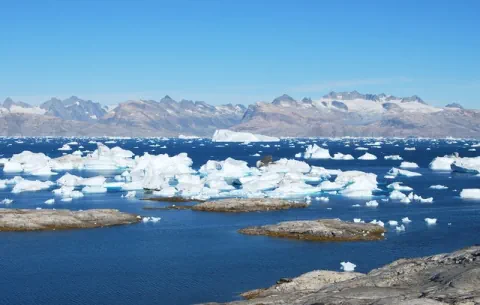
The Arctic is losing its sea ice at a rapid rate - Pexcels
Last year, the World Economic Forum reported that melting sea ice has caused the temperature in the Arctic to warm by 1°C (1.8°F) every decade for the last 40 years. This means that by 2035, the Arctic Ocean will probably be ice-free each summer.
How does Arctic Sea Ice Loss Effect Global Temperatures
As we lose Arctic sea ice and the ocean absorbs more sunlight, it heats the surrounding areas. So is why the arctic is heating faster than anywhere else in the world, a process known as arctic amplification. This localised heating increases water vapour which warms the air, raising temperatures further and causing permafrost within the arctic circle to thaw. This releases millions of dead plants and animals that were originally frozen in frost. As these decay, they release methane into the atmosphere, again increasing temperatures.
Add to this the CO2 we are constantly pumping into the atmosphere through burning fossil fuels and poor agricultural practices and the temperatures will just keep on rising!
In 2015, 196 countries signed a treaty: the Paris Agreement. The treaty aims to keep the rate of warming to below 2°C (3.6°F) and preferably below 1.5°C (2.7°F) compared to pre-industrial levels.
Global temperatures have been rising since the industrial revolution (c. 1760 to 1840). Today, the IPCC uses the 20-years of 1986 to 2005 as a reference period against which to measure current temperature rises. They set this period at 0°C (32°F).
However, pre-industrial levels were -0.6°C (-1.08°F) lower than the 0°C (32°F) reference point, so this needs to be taken into consideration when measuring global temperature rises.
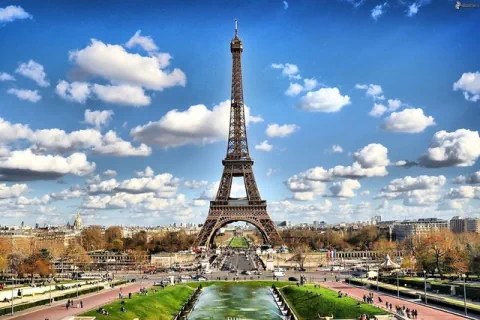
The Paris Agreement was signed in December 2015. Pexcels
2016 and 2020 tied for the hottest years recorded. This put the temperature for those two years at 1.02°C (1.84°F) above the pre-industrial rate. Although this seems quite a small rise, it will have an enormous impact on arctic sea ice.
So we can see the loss of sea ice is important, but how will this affect you and me?
How Will Sea Ice Loss Affect Us?
Some positive points could come from arctic warming. For example, the warmer temperatures might increase the arctic growing season, which means we could plant more trees to take carbon out of the atmosphere. However, according to the National Snow and Ice Data Centre, the negative effects far outweigh the positive ones.
So what are the negative effects, and what can we do about them? Here are 5 ways the loss of arctic sea ice might affect us.
Loss of arctic sea ice will add to the rising global temperatures
We have seen an increase in global temperatures. But temperature increases across the planet are not evenly spread.
For example, in Chad, the temperatures have already hit the 1.5°C limit and rainfall is decreasing. This has caused the lake that provides its drinking water to shrink by 90%. This is leading to food insecurity causing conflict, and people have started to leave the country, making them climate refugees.
The sad thing is that the people of Chad don’t have cars, no big industry, no aircraft, and many don’t have electricity. Each person has an annual carbon footprint of fewer than 0.1 tonnes (t) CO2 per year. Compare this to the UK, where people emit the equivalent of 5.5 t CO2 a year (which is 55 x more than Chad). The people of the USA have an even bigger carbon footprint. Each person emits 15.5 t CO2 a year (which is 150 x more than Chad).
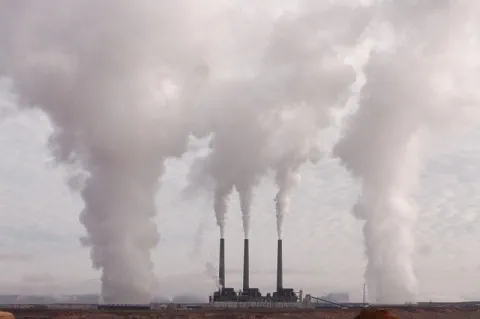
Factory pumping out CO2 emissions. Pixabay
Of course, these aren’t the only countries emitting high levels of CO2. Each person in Australia emits 17.3 t CO2. In Russia, it’s 12.5 t CO2 and in China, it’s 8.1 t CO2. You can check out your country’s carbon footprint here.
As temperatures rise, there will be an impact on food and water availability. Not just in Chad, but in many other parts of the world too. There are already conflicts over access to the water of the River Nile, and clashes like these will only get worse as the higher temperatures reduce these resources. This will lead to wars and an increase in the number of climate refugees. Where will these people go? Will the USA, China, Australia and other high emitting countries, take responsibility for the welfare of these people?
According to a report released in February 2021, by 2100, “summer is projected to last nearly half a year, but winter less than 2 months”.
Think back to the summer of 2020 and the wildfires that ripped across Australia and California. The rising temperatures will make these events more likely and more intense.
Loss of arctic sea ice will speed up sea level rise
There are two issues to consider here.
The first is to do with ice melting. Although the melting of arctic sea ice won’t increase sea levels itself. Just as ice melting in your gin and tonic won’t make your drink overflow. It will affect the land ice surrounding the arctic.

Like Arctic sea ice melt, this drink will not overflow when the ice melts. Pexels
As sea ice melts and the atmospheric temperature rises in the arctic circle, this will melt the adjoining glaciers and permafrost. These have had water locked up within them for millennia, and once they melt, they will discharge into the ocean. So now, if you have a glass filled to the top, adding more water into it will make it overflow. This will increase the height of the sea level.
The second issue is to do with the temperature of the water. Warm water takes up more space than cold water. Scientists call this thermal expansion. So when the ocean temperature rises, the water level will also rise as it’s taking up more room.
Due to both these reasons, sea-level rise is speeding up. According to Climate.gov, “Global mean sea level has risen about 8–9 inches (21–24 centimetres) since 1880.” In the last 15 years, the sea level has risen 2.5 x more quickly than it has done in the whole of the twentieth century. If things don’t change, by 2100 the sea level is likely to be 12 inches (30 cm) higher than it was in the year 2000. At 2°C (3.6°F) this figure doubles to 24 inches (60 cm).
We are way off track on meeting our carbon emissions predictions. As it currently stands, we are heading for a global temperature of over 3°C (5.4°F) by 2100. And the higher the temperature, the higher the sea level will rise.
A report carried out by the OECD suggested that Mumbai, Miami, Shanghai, New York, Tokyo and Jakarta were among the top 20 cities at risk of sea-level rise. Not to mention the effect this will have on millions of coastal town and villages. Many island nations could be lost altogether. Tuvalu, Kiribati and the Marshall Islands are already experiencing a sea-level rise. And to this list, you can add the Maldives, Seychelles, Fiji and the Cook Islands amongst many more.
Increases in the number and intensity of storms
The rise in sea temperatures across the arctic increases water vapour in the atmosphere. This rises and turns into clouds and rain. The clouds cool and when combined with more warm air from the ocean, become turbulent leading to violent storms. These unpredictable weather events, such as hurricanes and deluges, can cause flooding (as we saw in Bangladesh last year) and destruction (as in Hurricane Katrina that struck New Orleans in 2005). These storms are likely to become more regular and more intense.
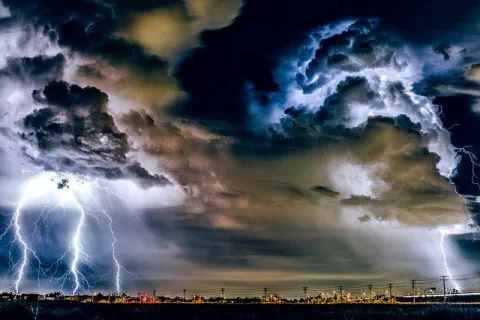
Storms will become more intense and destructive as the arctic warms up. Pixabay
It is likely that the arctic sea ice loss is also affecting the jet stream. The colder temperatures in the Arctic and the warmer temperatures in the lower latitudes is a driver of the jet stream. The substantial temperature rises in the Arctic could disrupt the trade winds and the effects of El Nino and La Nina, causing the jet stream to deviate from its usual path. This may be the reason for extreme weather patterns such as the unusually snowy conditions in Texas, USA early in 2021.
A reduction in sea ice puts Arctic animals (and humans) at risk
Many animals rely on arctic sea ice. Those at risk include polar bears, arctic foxes, reindeer, walruses, and many other species.
Sea ice loss destroys their ability to fish for food for themselves and their young. It takes away their resting points, forcing them to swim longer distances to care for their families. Losing their normal icy habitats brings them onto land, making them more vulnerable to predators and putting them into contact with people. This can further threaten their existence.
Through no fault of their own, arctic animals are being forced to adapt to these changes quickly or they will die as a result. Just as with other threatened species, these losses will have profound implications for our health and wellbeing.

Polar bear on disappearing sea ice. Pixabay
The loss of sea ice could bring more human traffic into the region
Sea ice loss will open up the Arctic to more humans, which could be catastrophic for the region. This could include:
-
More pollution – Wherever humans go they take their rubbish with them. We’ve already seen vast quantities of plastic pollution in the oceans around the world. The Beauford Gyre is the perfect place for the next ocean garbage patch. This could increase the number of microplastics we are all exposed to in the environment.
-
More commercial fishing – We’ve already seen the destruction of our oceans through fishing. Films like Seaspiracy have raised the profile of companies who seem unable to fish responsibly. Overfishing and excessive illegal bycatch will threaten more species with extinction, as with the bluefin tuna.
-
More commercial shipping passing through the ocean – Which could lead to control issues and conflict. Six countries border the Arctic Ocean. These are Canada, Greenland (belonging to Denmark), Iceland, Norway, Russia and the United States. But China is also trying to expand its influence in the region, even though it doesn’t border the area. Many have concerns about the long-term ramifications of the opening of the arctic ocean, leading to National Geographic describing this as the next Cold War. This could have consequences for our national security.
-
Fossil fuel extraction – Even though the planet needs to reduce its fossil fuel consumption, some want to exploit the region for these resources. This could have devastating consequences for wildlife, leading to further disruption of already depleted habitats. This industry will increase noise pollution, for both the animals and people, and add to the possibility of oils spills. It will also put more CO2 into the atmosphere at a time when we should be reducing this.
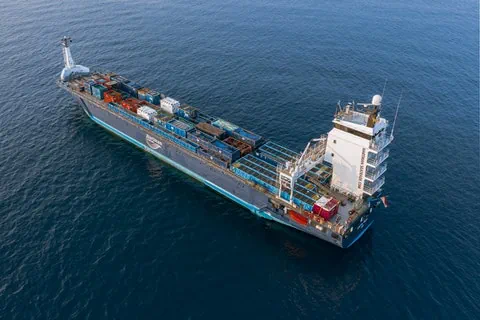
A frost-free Arctic Ocean could mean more commercial shipping. Pexels
What Can We Do to Reduce Arctic Sea Ice Loss?
Of course, there are always things we can do to reduce our impact on the planet, and Arctic sea ice loss is no different. However, we need to act quickly to prevent this from happening.
Here are some suggestions of how we can help with this problem.
Take some of the carbon out of the atmosphere
- Take steps to sequester carbon within your garden soil. Check out how you can do this here.
- Buy food that comes from farming activities that sequester carbon. For example, grass-fed meat, organic and biodynamic farming systems.
- Eat a more plant-based diet.
Reduce the amount of fossil fuel energy we use
- Drive less. Use public transport for work or work from home.
- Walk or cycle more.
- Invest in electric cars.
- Turn the temperature down in your home by 1°C (1.8°F). This will save you money too.
- Turn off lights when not in use.
- Switch off items on standby.
- Delete any emails you have finished with.
- Buy energy from companies that use renewable fuel sources.
- Cook more efficiently, using one cooking source at a time. Steamers are an excellent investment to help with this.
- Invest in new renewable energy heating systems for your home.
- Buy energy-efficient equipment (fridges, freezers, light bulbs, etc).
- Dry your washing outside rather than tumble drying.
- Reduce the amount of single-use plastic you buy.
Holiday at home rather than flying abroad
- Check our guide for zero waste travelling
- Take the opportunity of exploring your own country for your holiday destination.
- Use the train to travel around your country or travel abroad by train instead of flying.